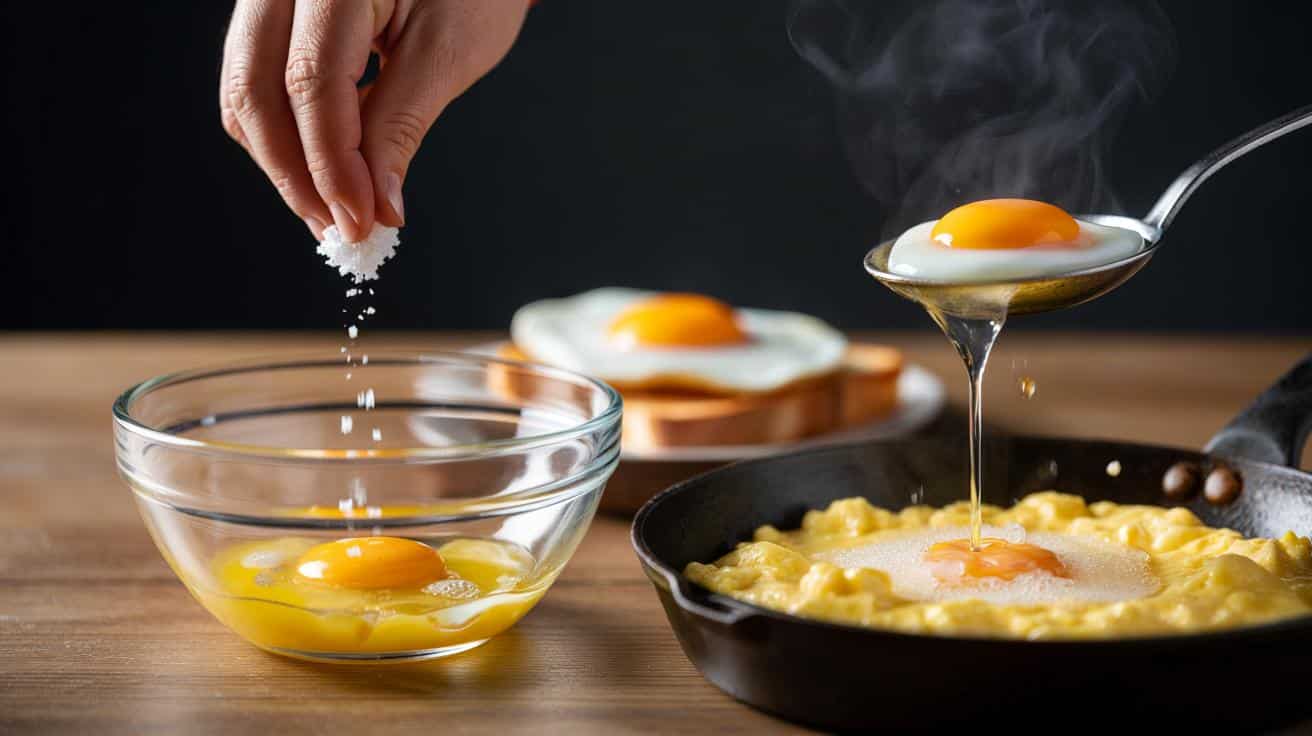A pinch of salt seems too small to matter. Yet every time it hits an egg, something shifts — softer curds, neater edges, a brighter yolk. The plate looks calmer. Your fork meets less fight. Why does this tiny sprinkle keep making breakfast better?
The kitchen was quiet, apart from the whisper of butter melting at the edges. When the eggs set, the whites looked glossy, the yolks domed like little suns.
I’d done almost nothing. Same pan, same hob, same eggs. The only reliable variable was salt — added before heat. The results felt kinder, more forgiving, as if the eggs wanted to cooperate. The difference wasn’t loud. It was unmistakable.
*The science sneaks in where the steam rises.*
The quiet magic of a pinch of salt
Salt changes how egg proteins behave as they warm. Proteins love to tangle when heated, building tight networks that can turn squeaky or rubbery. A little salt interrupts that rush to clump, keeping things looser for longer.
Think of sodium and chloride as tiny cushions. They slip between strands of albumen proteins, blunting their urge to grab each other too fast. The upshot is gentler coagulation, a slower set, and a silkier bite. **Salt raises the coagulation temperature** just enough to widen your margin of error.
In scrambled eggs, that extra breathing room tastes like creaminess without cream. In fried eggs, it’s the difference between a white that goes glassy and one that stays plush. In poached eggs, it helps the surface seal if a crack happens, so you don’t trail wisps across the pan.
I tested it two ways, side by side. Two bowls of eggs, whisked lightly. One salted as soon as it hit the bowl and rested a few minutes. The other left plain until it met the heat. Same butter, same flame, same spatula.
The salted batch set into tender, small curds, almost custardy. The unsalted one tightened quicker and needed more wrist work to stay soft. The difference wasn’t huge, but it was consistent. We’ve all had that moment when breakfast mood turns on a dime — salt tipped it the right way.
Boiled eggs tell a similar story. Add salt to the water and the boiling point barely shifts — about 0.17°C for a teaspoon per litre — so it won’t cook faster. What it does do is nudge leaking whites to firm faster if a shell cracks. Your pot stays clearer, your egg less ragged, your morning less fussy.
How to salt eggs like a pro (and what trips us up)
Salt early for scrambled and omelettes. Whisk eggs with a pinch per egg and let them sit for 5 to 10 minutes while you heat the pan. That rest lets salt dissolve and loosen the protein web. The curds will form later and stay soft longer.
For fried eggs, season the surface as soon as the whites go from translucent to milky. The grains melt into a thin brine that coaxes even setting. For poaching, salt the egg lightly after it lands on toast, not the poaching water; a splash of vinegar in the pan does the heavy lifting.
Let’s be honest: no one salts and rests eggs perfectly every day. Yet small habits stack up. A pinch in the bowl for scrambled. A sprinkle on the white mid-cook for fried. And skip salting meringue — salt weakens foams. **Season early** where heat meets a pan, not where air meets a whisk.
“Salt doesn’t just make eggs taste better; it gives you time. Time is texture.”
- Scrambled: pinch per egg in the bowl, 5–10 minutes rest.
- Fried: sprinkle when the white turns milky, not at the end.
- Poached: vinegar in water; salt on toast after.
- Boiled: salting the water helps leaks, not peeling.
- Whipped whites: add acid, not salt.
There’s a quiet logic at play. Salt increases the ionic strength of the egg mixture, which “shields” charged spots on proteins. With fewer exposed charges, the strands are less desperate to bind the first moment they heat.
The result: **Use less heat than you think** and you’ll get curds that form slowly, not seize. Gentle heat plus early salt turns your pan into a kinder place. That combo keeps moisture inside the network rather than squeezing it out onto the plate.
One more nudge. For fried eggs with lacy edges, salt after the flip. For a set white and jammy yolk, cover the pan for 30–45 seconds and let the briny steam finish the top. Tiny adjustments, big breakfast wins.
A bigger idea hidden in a breakfast
The egg is a small laboratory. Salt is the control switch you hold in your fingers. You can use it to buy time, to smooth heat, to soften the edges of a morning. It’s not a chef’s trick so much as a gentle reminder that flavour and physics sit at the same table.
When you salt early, you’re choosing texture before taste. The taste comes anyway. When you salt at the right moment in the pan, you’re choosing how the set will carry through to the plate. One pinch changes the chain reaction, from whisk to fork.
I like that cooking can be this simple and this nerdy in the same breath. A teaspoon in water won’t do miracles; a pinch in the bowl often will. Breakfast is a daily test you don’t have to cram for. And the answer might already be in your fingers.
| Key points | Detail | Reader benefit |
|---|---|---|
| Early salt slows coagulation | Salt raises the set temperature and loosens protein bonds | Softer curds, wider margin for error |
| Salt the egg, not poaching water | Vinegar tightens whites; salt after for flavour | Clean poaches without feathery whites |
| Salted water helps if shells crack | Leaking whites firm faster in briny water | Neater boiled eggs, less cloudy pots |
FAQ :
- Should I salt scrambled eggs before or after cooking?Before. A small pinch per egg in the bowl, then a short rest, gives you creamier curds and a gentler set.
- Does salt make boiled eggs easier to peel?Not much. Age and pH matter more. Older eggs peel better; a touch of bicarb in the water helps more than salt.
- Will salt toughen eggs?No at normal levels. Early salting actually tenderises by slowing protein cross-linking. Overcooking is what makes eggs rubbery.
- Should I add salt to egg whites for meringue?No. Salt weakens foams. Use a pinch of acid, like lemon juice or cream of tartar, to stabilise the whip.
- How much salt is “a pinch”?Roughly 0.3–0.5 g, or two to three fingers’ worth. For scrambled, think one pinch per egg; adjust to taste once it’s on the plate.








